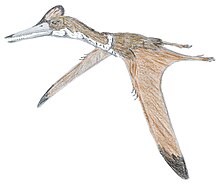Kryptodrakon
| Kryptodrakon | |
|---|---|

| |
| Life restoration | |
| Scientific classification | |
| Domain: | Eukaryota |
| Kingdom: | Animalia |
| Phylum: | Chordata |
| Order: | †Pterosauria |
| Suborder: | †Pterodactyloidea |
| Genus: | †Kryptodrakon Andres, Clark & Xu, 2014 |
| Type species | |
| †Kryptodrakon progenitor Andres, Clark & Xu, 2014
| |
Kryptodrakon is an extinct genus of pterodactyloid pterosaur from the Middle to Late Jurassic with an age of approximately 162.7 million years.[1] It is known from a single type species, Kryptodrakon progenitor. The age of its fossil remains made Kryptodrakon the basalmost and oldest pterodactyloid known to date.[1][2]

Discovery and naming
In 2001, pterosaur bones were discovered in
In 2014, Brian Andres, Clark and Xu Xing named and described the type species Kryptodrakon progenitor. The generic name means hidden dragon from Greek κρυπτός, kryptos (hidden), and δράκων, drakon (dragon). The name alludes to the film Crouching Tiger, Hidden Dragon, which included some scenes filmed near the type locality. The specific name progenitor means ancestor or founder of a family in Latin, and refers to the animal's status as the most basal member of the Pterodactyloidea.[1]
The holotype, IVPP V18184, was uncovered in a layer of the Shishugou Formation dating from the Callovian–Oxfordian and having a minimum age of 161 million years. It consists of a partial skeleton lacking the skull. It contains fragments of both wings including the right fourth metacarpal, parts of the shoulder girdle and the second sacral vertebra. The bones were not articulated but were discovered in a small area of 30 square centimeters (4.7 sq in), at a considerable distance from other fossil remains, and thus likely represent a single individual. The bones were largely preserved three-dimensionally, without strong compression. The holotype probably was an adult individual.[1]
Description
Kryptodrakon has an estimated
Phylogeny
The main author performed a
Below is a
Paleobiology
Kryptodrakon lived in a
See also
References
- ^ PMID 24768054.
- ^ Chachere, Vickie (April 24, 2014). "International Scientific Team Discovers, Names Oldest Pterodactyloid Species". USF News. Archived from the original on April 26, 2014. Retrieved April 25, 2014.
- ^ Dell'Amore, Christine (April 24, 2014). "Meet Kryptodrakon: Oldest Known Pterodactyl Found in China". National Geographic, Daily News. Archived from the original on April 25, 2014.
